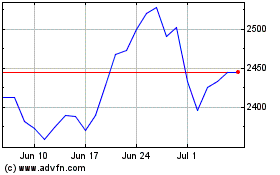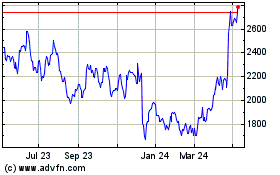By Chester Dawson
GAHCHO KUÉ, Northwest Territories -- The world's biggest diamond
producer is making an expensive bet on what lies beneath the
permafrost in this desolate region of Canada's high north.
On Tuesday, De Beers, a unit of Anglo American PLC, officially
opened the new diamond mine after nearly 20 years of preparation, a
$1 billion gamble that the current decline in the market for
high-end jewelry will reverse as older mines close.
Anglo American is counting on extracting 4.5 million carats a
year as it sheds coal and other assets and focuses on diamonds,
copper and platinum. The precious gems accounted for 42% of Anglo's
earnings in its latest quarter and have emerged as a bright spot
for a company struggling with a prolonged downturn in raw materials
prices.
"We are building our long-term future with diamonds at the core
of our business," said Mark Cutifani, Anglo's chief executive, at
the mine's opening this week. Diamonds hold promise, he said in an
interview, because there haven't been any major discoveries over
the past two decades "and the industry is going into deficit."
Mr. Cutifani is scaling back Anglo's mining businesses to 16
from 45, and cutting its staff by half, as part of an aggressive
paring of the company's debt, which stood at $11.7 billion on June
30. Mr. Cutifani has pledged to bring it below $10 billion by the
end of this year.
Its Gahcho Kué mine is the world's first major new diamond pit
since the Diavik project in 2003, a neighboring northern Canadian
mine run by Rio Tinto Group. Industry analysts say the De Beers
mine is one of the last mega-size properties set to open this
decade.
The giant strip mine is located in a remote area with no paved
roads about 175 miles northwest of Yellowknife, the territorial
capital. Its name means "the place of big rabbits" in the local
aboriginal language.
Work crews must be flown in and housed in on-site camps,
blizzard condition "whiteouts" can shut down production and the
mine's supply chain relies on seasonal ice roads to ship in fuel
and heavy equipment. It is among the highest-cost diamond
extraction operations in the world, along with those in Russia's
north and off the coast of Namibia.
Canadian diamonds are typically top-grade rocks that can fetch
premium prices. De Beers says its other mine in Canada, called
Victor, produces some of the world's highest value diamonds.
Canada also offers De Beers geographic diversification from its
historical base of operations in Africa, especially Botswana; that
helps the company diffuse some consumers' discomfort with African
diamond sourcing. While De Beers has vowed to avoid so-called blood
diamonds, whose proceeds may be used by warlords, Canadian
production carries no such stigma.
"Clearly, Canada is about as good as it gets from that point of
view," De Beers CEO Bruce Cleaver said in an interview. "Everywhere
we mine, ethical sourcing is a material issue and has always been
for us," he said.
Weak demand from key markets in Asia, including China, has
weighed on diamond prices, with prices for rough-cut stones
dropping 18% in 2015 -- the steepest decline since 2008, according
to credit-rating firm Moody's Investors Service Inc.
That gap between demand and supply is expected to continue to
depress prices for at least the remainder of this year, before
producers cut back allocations and output declines at mines that
are headed for retirement next decade.
Still, diamonds have been shielded from the worst of a price
slump affecting many other commodities, in part because just three
companies control about two-thirds of the world's supply of rough
cut, or unpolished, diamonds.
De Beers, with a 25% global market share by volume, is second
only to Russia's PAO Alrosa and trailed by Rio Tinto.
Production at De Beers's newest mine began to ramp up in August,
and will reach full capacity by early next year. Gahcho Kué's fleet
of two-story-tall Komatsu trucks work 24 hours a day, seven days a
week hauling diamond-rich ore from the open pit to a processing
plant standing nearly 10 stories high on the barren horizon.
Inside, thousands of tons of ore pass through a series of chutes
and filters, including De Beers's proprietary X-ray and laser-beam
equipment in the final stages, to extract thousands of rough cut
diamonds an hour.
De Beers owns 51% of Gahcho Kué and is the operator for junior
partner Mountain Province Diamonds Inc., which staked the original
claim in the early 1990s.
The mine's opening comes less than a year after De Beers closed
another diamond mine nearby, called Snap Lake, ending production
years earlier than originally planned at the money-losing
facility.
Company officials say that project was doomed by an uneven
distribution of diamond-rich ore and a waterlogged subterranean
mine. Based partly on that experience, De Beers decided not to dig
under a lake at Gahcho Kué, but instead drained it -- and donated
its 18,403 fish to feed local communities.
--Scott Patterson contributed to this article.
Write to Chester Dawson at chester.dawson@wsj.com
(END) Dow Jones Newswires
September 23, 2016 05:44 ET (09:44 GMT)
Copyright (c) 2016 Dow Jones & Company, Inc.
Anglo American (LSE:AAL)
Historical Stock Chart
From Mar 2024 to Apr 2024

Anglo American (LSE:AAL)
Historical Stock Chart
From Apr 2023 to Apr 2024
